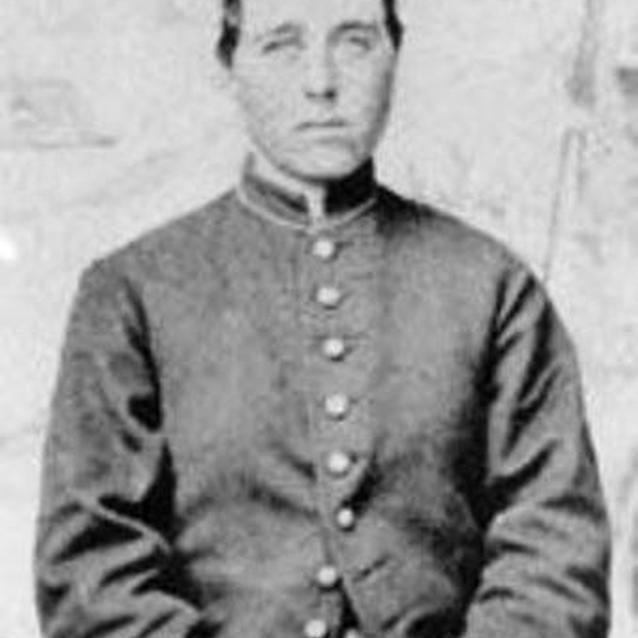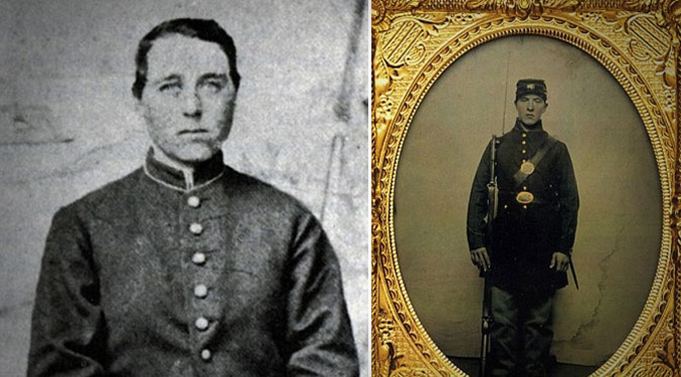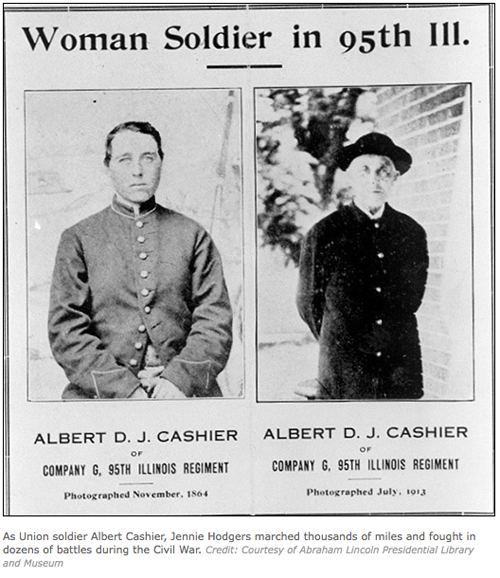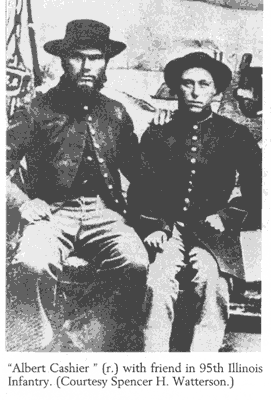Birth name Jennie Irene Hodgers Name Albert Cashier | Other work Farmhand, janitor Years of service 1862–1865 | |
 | ||
Battles/wars Vicksburg, Red River, Guntown Died October 10, 1915, Illinois, United States Similar People Sarah Rosetta Wakeman, Frances Clalin, Pauline Cushman | ||
Albert cashier
Albert D. J. Cashier (December 25, 1843 – October 10, 1915), born Jennie Irene Hodgers, was an Irish-born immigrant who served in the Union Army during the American Civil War. Cashier adopted the identity of a man before enlisting, and maintained it for most of the remainder of her life. She became famous as one of a number of women soldiers who served as men during the Civil War, although the consistent and long-term commitment to the male identity has prompted some contemporary scholars to suggest that Cashier was a trans man.
Contents
- Albert cashier
- Betty kay carolton albert cashier at il state military mueseum
- Early life
- Enlistment
- During the war
- Postwar
- Death and legacy
- References

Betty kay carolton albert cashier at il state military mueseum
Early life

Hodgers was born in Clogherhead, County Louth, Ireland on December 25, around the year 1843. According to later investigation by the administrator of her estate, she was the child of Sallie and Patrick Hodgers. Hodgers's later accounts of how she moved to the United States and why she enlisted were taken when she was elderly and disoriented, and she was also typically evasive about her earlier life; therefore, these narratives are contradictory. Typically, she was said to have been dressed in boy's clothing by her stepfather in order to find work. Even before the advent of the war, Hodgers adopted the identity of Albert Cashier to work. Her mother died sometime in her youth, and by 1862, Hodgers had traveled as a stowaway to Illinois and was living in Belvidere.
Enlistment
Hodgers first enlisted in July 1862 after President Lincoln's call for soldiers. As time passed, the need for soldiers only increased. On August 6, 1862, she enlisted in the 95th Illinois Infantry for a three-year term using the name "Albert Cashier" and was assigned to Company G. A company catalog lists Cashier as nineteen years old upon enlistment, a farmer from New York City, 5 feet 3 inches tall, blue-eyed, and of a fair complexion.
During the war

The regiment was part of the Army of the Tennessee under Ulysses S. Grant and fought in approximately forty battles, including the siege at Vicksburg. This campaign proved to be a challenge for Cashier, as she was captured while performing reconnaissance. Cashier managed to escape, however, and make her way back to the regiment. After the Battle of Vicksburg, in June 1863, Cashier contracted chronic diarrhea and entered a military hospital. Somehow, she evaded detection.

The regiment was also present at the Red River Campaign and the combat at Guntown, Mississippi, where they suffered heavy casualties. Throughout the war, the regiment traveled a total of about 9,000 miles during its term. Other soldiers thought that Cashier was small and preferred to be alone, which were not uncommon characteristics for soldiers. Cashier fought with the regiment through the war until August 17, 1865, when all the soldiers were mustered out. Cashier was honorably discharged on August 17, 1865.
Postwar
After the war, Cashier returned to Belvidere, Illinois for a time, where she worked for Samuel Pepper and maintained her wartime identity. She settled in Saunemin, Illinois, in 1869, where she worked as a farmhand as well as performing odd jobs around the town. Albert Cashier can be found on records of the town payroll. Her employer there, Joshua Chesebro, built a one-room house for her. For over forty years, she lived in Saunemin and was a church janitor, cemetery worker, and street lamplighter. Because she lived as a man, she was able to vote in elections and later claimed a veteran's pension under the name Albert Cashier. In later years, she ate with the neighboring Lannon family. Later on, when Hodgers fell ill, the Lannons discovered that she was female when they asked a nurse to examine her, but they did not make their discovery public.

In 1911, Cashier was hit by a car that broke her leg. A physician discovered her secret in the hospital, but did not disclose the information. On May 5, 1911, because she was no longer able to work, Cashier was moved to the Soldiers and Sailors home in Quincy, Illinois. During this stay, Hodgers was visited by many of her fellow soldiers from Ninety-fifth Regiment. She lived there until her mental state deteriorated and she was moved to the Watertown State Hospital for the Insane in March 1914. Attendants at the Watertown State Hospital discovered that she was female when giving her a bath, at which point she was made to wear women's clothes again after fifty years.
Death and legacy
Albert Cashier died on October 10, 1915. She was buried in the uniform she had kept intact all those years and her tombstone was inscribed "Albert D. J. Cashier, Co. G, 95 Ill. Inf." Cashier was given an official Grand Army of the Republic funerary service, and was buried with full military honors. It took W.J. Singleton (executor of Cashier's estate) nine years to track Cashier's identity back to her birth name of Jennie Hodgers. None of the would-be heirs proved convincing, and the estate of $418.461 was deposited in the Adams County, Illinois, treasury. In the 1970s, a second tombstone, inscribed with both of her names, was placed beside the first.
Also Known As Albert D. J. Cashier: The Jennie Hodgers Story is a biography written by veteran Lon P. Dawson, who lived at the Illinois Veterans Home where Cashier once lived. The novel My Last Skirt, by Lynda Durrant, is based on her life. Cashier's house has been restored in Saunemin.
Authors including Michael Bronski, James Cromwell, Kirstin Cronn-Mills, and Nicholas Teich have suggested or argued that Cashier was a trans man.
